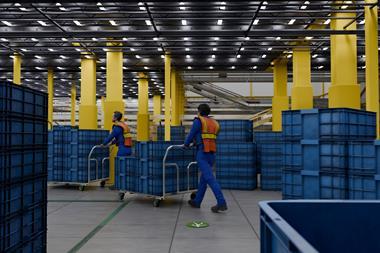Expert negotiating and management of inventory will both be necessary if retailers are to protect their margins from the kind of rise in shipping costs seen recently, writes Alison Clements

P utting jeans, toasters and toys on the proverbial ‘slow boat’, in this case from rather than to, China became a low-cost option during the 2008 economic downturn, when shipping lines struggled to fill to capacity. But retailers buying from Asia have had to factor in massively increased costs of shipping goods into Europe in the past 18 months as the fortunes of container shipping lines such as Maersk and Hapag-Lloyd recovered.
Now many retailers’ commercial departments are sweating over how much further margins might be hit in 2011 and how to minimise risk if the perceived shortage or unreliability of ocean-going freight space continues.
In this climate, relations between shipping lines and retailers are strained. Argos is believed to be suing Maersk Line, the Danish logistics group, which handles more than 4 million container movements to the UK each year. The retailer has filed a High Court claim for compensation after the shipping line allegedly reneged on a contract to ship 5,000 40ft containers from the Far East to the UK and attempted to impose a three-fold price increase in January.
Containing the costs
Certainly price hikes have hit retailers hard. “In the recession, when importing dropped off, it was costing retailers as little as $600 to ship a 40ft container in from the Far East, but we are having to tell them it’s about $3,800 today,” says Paul Boland, group imports manager of The Elite Group, a third-party logistics provider, who deals with many worried retail clients. He adds: “February this year was the peak, when the shipping lines had all removed vessels and slowed ships down to save money and prices began inflating as demand for space suddenly picked up. Then prices hit the $4,000 mark.”
B&M Retail imports controller Jerome Wildsmith says there has been a softening of these “crazy” prices in the past couple of months. “Things went off the scale when the banks started lending again and retailers got back to buying from the Far East. Demand for space shot up and shipping prices hit unprecedented levels. But we are at a plateau now, and I don’t expect that volatility again. At one point the shipping lines were dictating prices, but now suddenly they want market share again and are coming to us a bit more.”
With shipping costs up an estimated 75% in the past year, the only option has been to put retail prices up.
“Your costings go up in line with the shipping costs, so you have to adjust your price points,” says Wildsmith. “There have been fuel surcharges to cope with as well and, of course, production costs are getting higher.”
Shipping consultants predict that demand for container ships will cool off now that stores and factories have replenished inventories. “But a big concern looking ahead is shipping line reliability,” says Alan Braithwaite, chairman of LCP Consulting and a visiting professor at Cranfield School of Management. “Retailers are not feeling confident about availability of space and lead times and, if they’re running a promotion or have sudden surges in demand for hot products, they can’t afford to let things go to the wire.”
Drewry, the UK-based independent shipping analysts, recently published a report on schedule reliability and, based on its findings, questions the link between freight rates and reliability. From the first quarter of 2010, schedule reliability across the container shipping industry fell to just 45% between April and June. While Maersk Line recorded a slight improvement, many shipping companies are seen to be underperforming, with only half of the top 20 carriers (ranked by vessel capacity) achieving 50% reliability or above. Retailers are being advised to take steps to mitigate the risk of goods being left on the dockside or stuck at sea for weeks on end.
There also remains the ongoing issue of fuel price rises. “With shipping problems hitting the headlines, and fuel price volatility expected to continue, retailers are being forced to rethink their supply chain strategies,” says Gary Hanifan, senior executive for UK and Ireland at Accenture’s Supply Chain Practice. “Sourcing from China makes economic sense if fuel prices and shipping costs are manageable, but without those guarantees, people are thinking more about sourcing near-shore - perhaps in Turkey or Eastern Europe,” he says. “Certainly keeping some production closer to home removes an element of risk.”
He also recommends being prepared to switch to other modes of transport - air freight, rail or road - if sea container space is constrained or proving too costly and unreliable. “Working with freight forwarders is a good way to proceed if you’re looking for flexibility, as they are contracted to find the best route at the best cost to suit your particular product and desired lead times,” says Hanifan.
Freight forwarders are well-positioned and have the scale to make use of multiple carriers too, again spreading costs. “Segmentation is key, so that you’re not treating everything in the same way. Some of your inventory can take the slower, low-cost route but, for a percentage of stock, you’ll want to pay more for speed to market.”
As ever, using data to forecast accurately can protect precious margin, and supply chain experts think buying skills could be the key to mitigating supply chain costs and risks.
“Ocean freight costs account for 2% to 4% of cost price but, if that’s creeping up past 5% at the same time as buying prices are going up, and with a VAT rise to factor in, you risk depressing retail volumes because prices in store are going up,” says Braithwaite. “Information in the supply side of the business therefore becomes absolutely critical. You need to be buying exactly the right volumes - and at the right prices - to avoid overstocks and mark-downs, and working with suppliers and freight forwarders to get just the right amount of product into stores.”
He adds: “Meticulous inventory management has never been more important. That’s going to be the real skill - something retailers haven’t had to work so hard at in the past 10 years.”
Hanifan at Accenture agrees. “The slow boat from China will continue to appeal, because it’s likely that fuel prices will make air freight untenable,” he says. “But long-distance shipping only works so long as you can achieve 80%-plus accuracy from that shipment. That’s where vital cost savings can be made.”
Shipping costs and shortages explained
Shipping costs
Rates per 40ft container plummeted from a 2007 level of $3,800 to as low as $600 during 2008 as shipping lines fought for market share. In order to correct the supply/demand equation, lines removed capacity (by laying up vessels). This over-corrected the market, forcing rates to peak above $4,000. The capacity has since been reinstated and rates have settled at 2007 levels. So, although they appear high, when viewed in the longer term they are within the bounds of expectation. Retailers should expect 40ft rates to hover around the $3,000 mark over the next 18 months, with occasional blips in the market.
Container shortage
There has historically been a stock of 2.2 containers per available container space on vessels, but the ratio is currently running at 1.72. The lines had predicted that a shortage would hit the industry by August, but the issue did not arise. The forecasts are that, if a shortage does hit the market, it will occur towards the end of the traditional peak of October/November. However, there is scepticism that it will become an issue at all, except perhaps at outlying origins. It is not expected to be a long-term issue. In future, shipping lines are likely to be quicker to remove capacity from the market to stop rates falling below certain levels, so we should not see the violent swings of the past two years.


























No comments yet